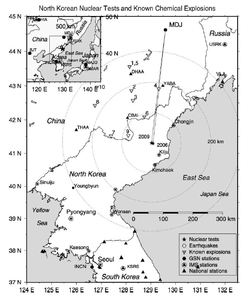 The previous issue of Science & Global Security carried an article that offered evidence from radionuclide signals detected in South Korea, Japan, and Russia that in May 2010 North Korea may have carried out one or more nuclear tests ("Radionuclide Evidence for Low-Yield Nuclear Testing in North Korea in April/May 2010" by Lars-Erik De Geer, Volume 20, No. 1, 2012.)
The previous issue of Science & Global Security carried an article that offered evidence from radionuclide signals detected in South Korea, Japan, and Russia that in May 2010 North Korea may have carried out one or more nuclear tests ("Radionuclide Evidence for Low-Yield Nuclear Testing in North Korea in April/May 2010" by Lars-Erik De Geer, Volume 20, No. 1, 2012.)
In the current issue, David P. Schaff, Won-Young Kim, and Paul G. Richards respond with a detailed analysis of seismic signals from North Korea (free PDF of the article) recorded by a nearby station in northeastern China on the days in May 2010 proposed by De Geer as dates for the possible tests. The article concludes that no well-coupled underground explosion above about one ton TNT equivalent occurred near the North Korea test site on those days. This offers a stringent limit on any testing scenario.
The technique used in the new article significantly increases the sensitivity of seismic monitoring for the region in question. It offers sensitive new tools for forensic, after-incident seismic analysis to complement the first response seismic methods used by the International Monitoring System of the Comprehensive Test Ban Treaty Organization.
The other papers in this double issue of the journal focus on the use of computer modeling for understanding the proliferation risk from research reactors and small plutonium production reactors and advancing options for reducing this risk. Three articles explore questions of plutonium production, and a fourth article offers a new idea for furthering the conversion of highly enriched uranium fueled research reactors to low-enriched uranium fuel. Taken together, these articles demonstrate the significant advances in analysis that computer modeling now offers for supporting and improving nonproliferation policy. It may be fruitful to bring together the nonproliferation community and the computer modeling community in a focused effort to develop new dedicated open-source computer codes and tools for nonproliferation and disarmament studies.
The final contribution in this issue is a review of Our Own Worst Enemy? Institutional Interests and the Proliferation of Nuclear Weapons Expertise by Sharon K. Weiner (MIT Press, 2011). The book deals with U.S. efforts to organize cooperative threat reduction (CTR) programs with Russia and other former Soviet states to reduce the risk of former Soviet scientists and engineers with expertise in nuclear, chemical, or biological weapons from proliferating their knowledge. The review describes it as a "thorough, meticulously researched book" and recommends it as "an authoritative resource to those who study or want to successfully implement CTR-type projects, regardless of their geographical location."
